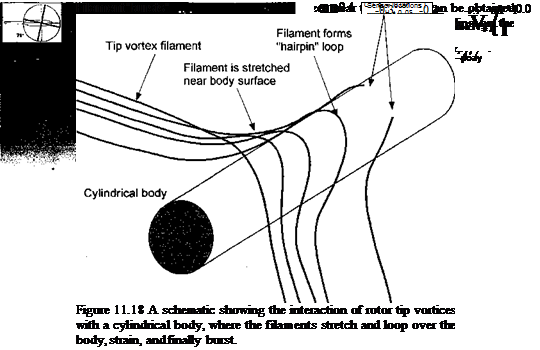Type-3 Interactions: Wake-Surface Impingement
A third type of pressure signature often measured on helicopter airframes is shown in Fig. 11.13(c). This signature occurs when direct impingement of a tip vortex occurs near the measurement point, a fact confirmed by flow visualization experiments. For example, such an interaction made visible using the shadowgraph technique (see Section 10.2.3) is shown in Fig. 11.17. The tip vortex filaments appear as thin dark lines. Near the body surface the local wake skew angle increases progressively as the filaments asymptotically approach the body surface. The tip vortices also undergo significant local stretching (both laterally and longitudinally) before the action of viscosity causes the vortices to burst. The schematic in Fig. 11.18 shows the observed wake behavior in more detail. As the filaments reach the

body surface they distort to form a loop or hairpin vortex structure. These vortex-surface interactions and their effects on the surface pressure, poses a complex problem in vortex dynamics because they involve a complex balance of inertia, pressure, and viscous forces – see Atias & Weihs (1984), Doligalski & Walker (1984), Walker et al. (1987), and Lim (1989). The physics of these complicated wake distortions have also been studied in detail by Conlisk et al. (1993) and Moedersheim et al. (1994), by means of flow visualization, and modeling these effects is discussed by Quackenbush & Bliss (1988), Quackenbush et al. (1990, 1994), and Conlisk & Affes (1993). Progressive transitions from Type-3 to Type-2 interactions (or vice versa) will be found during adjustments of the advance ratio and/or rotor thrust that adjust the position of the rotor wake relative to the body.











